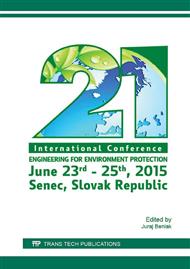p.18
p.23
p.31
p.39
p.49
p.55
p.63
p.69
p.79
Steam Biomass Gasification - Effect of Temperature
Abstract:
Gasification is one of the technologies for utilization of biomass. Gasification is a transformation process that converts solid fuels into gaseous fuels. The gaseous fuel may be subsequently applied in other technologies with all the benefits that gaseous fuels provide. The principle of biomass gasification is a common knowledge. It is thermochemical decomposition oof the fuel in presence of gasification agent. Heat from the endothermic reaction is obtained by a partial combustion of the fuel (autothermal gasification) or the heat is supplied into a gasifier from the outside (allothermal gasification). Oxygen for the partial combustion is supplied in the gasification medium. Quality, composition and amount of the producer gas depend on many factors which include type of the gasifier, operating temperature and pressure, fuel properties (moisture content) and type and amount of gasification medium. Commonly, air, steam and oxygen and their combinations are used as a gasification medium. Every kind of gasification agents has its significant advantages and disadvantages.Research and analysis of the gasification process must pay special attention to all operating parameters which affect quality and amount of the producer gas that is the efficiency of the conversion itself. Composition of the producer gas, calorific value, and content and composition of impurities are especially observed as these are the basic characteristics directly affecting subsequent application of the gas. Steam addition has a significant impact on gas composition. Steam decomposition into hydrogen and oxygen, and their subsequent reactions increases amount of combustibles, hydrogen, methane and other hydrocarbons. Steam addition in the gasification also affects amount and composition of tar and has a negative impact on heat balance.Energy Institute at the Brno University of Technology has a long tradition in research of biomass gasification in atmospheric fluidized bed reactors. Air was used as a gasification medium. This paper describes our experience with gasification using a mixture of air and steam. We analysed the whole process and in this paper we wish to describe the impact of temperature on outputs of the process, especially temperature of leaving steam and temperature of gasification reactions.
Info:
Periodical:
Pages:
49-54
Citation:
Online since:
April 2016
Authors:
Keywords:
Price:
Сopyright:
© 2016 Trans Tech Publications Ltd. All Rights Reserved
Share:
Citation:


